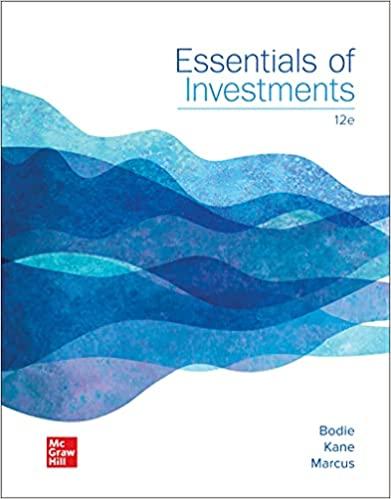Question
When we pick these upper and lower bounds, we are not ruling out the possibility that the actual values could be outside this range. What
When we pick these upper and lower bounds, we are not ruling out the possibility that the actual values could be outside this range. What we are saying, again loosely speaking, is that it is unlikely that the true average (as opposed to our estimated average) of the possible values is outside this range. An example is useful to illustrate this idea. Lets assume the project under consideration costs $200,000, has a five-year life, and no salvage value. Depreciation is straight-line to keep our example simpler. The required return is 12% and the tax rate is 34%. In addition, we have compiled the following information: Page 397 With this information, we can calculate the base-case NPV by first calculating net income: 2 Base Case Lower Bound Upper Bound Unit sales 6,000 5,500 6,500 Price per unit $80 $75 $85 Variable costs per unit 60 58 62 Fixed costs per year 50,000 45,000 55,000 Sales $480,000 Variable costs 360,000 Fixed costs 50,000 Cash flow is thus $30,000 + 40,000 10,200 = $59,800 per year. At 12%, the five-year annuity factor is 3.6048, so the base-case NPV is: The project looks good so far. What we are going to do next is recalculate NPV, varying some key inputs such as unit sales, price per unit, variable costs per unit, and fixed costs. With the base-case calculations completed, you can see why we assumed straight-line depreciation. It allows us to focus on key variables without the complications of calculating net income separately for each year or using the PVCCATS formula. Of course, for full accuracy, you should employ the CCA rules.When we pick these upper and lower bounds, we are not ruling out the possibility that the actual values could be outside this range. What we are saying, again loosely speaking, is that it is unlikely that the true average (as opposed to our estimated average) of the possible values is outside this range. An example is useful to illustrate this idea. Lets assume the project under consideration costs $200,000, has a five-year life, and no salvage value. Depreciation is straight-line to keep our example simpler. The required return is 12% and the tax rate is 34%. In addition, we have compiled the following information: Page 397 With this information, we can calculate the base-case NPV by first calculating net income: 2 Base Case Lower Bound Upper Bound Unit sales 6,000 5,500 6,500 Price per unit $80 $75 $85 Variable costs per unit 60 58 62 Fixed costs per year 50,000 45,000 55,000 Sales $480,000 Variable costs 360,000 Fixed costs 50,000 Cash flow is thus $30,000 + 40,000 10,200 = $59,800 per year. At 12%, the five-year annuity factor is 3.6048, so the base-case NPV is: The project looks good so far. What we are going to do next is recalculate NPV, varying some key inputs such as unit sales, price per unit, variable costs per unit, and fixed costs. With the base-case calculations completed, you can see why we assumed straight-line depreciation. It allows us to focus on key variables without the complications of calculating net income separately for each year or using the PVCCATS formula. Of course, for full accuracy, you should employ the CCA rules.
IN THIS YOU HAVE CALCULATE THE NPV , PAYBACK PERIOD, DISCOUNTED CASH PAYBACK PERIOD ,IRR AND MIRR
Step by Step Solution
There are 3 Steps involved in it
Step: 1

Get Instant Access to Expert-Tailored Solutions
See step-by-step solutions with expert insights and AI powered tools for academic success
Step: 2

Step: 3

Ace Your Homework with AI
Get the answers you need in no time with our AI-driven, step-by-step assistance
Get Started


